This is an AI Free Zone! Text created by ChatGPT and other Large Language Models is spreading rapidly across the Internet. It's well-written, artificial, frequently inaccurate. If you find a mistake on Spaceweather.com, rest assured it was made by a real human being. | | |
HUGE NEW SATELLITE OUTSHINES ALMOST EVERY STAR: A paper published this week in the research journal Nature examines the alarming brightness of Bluewalker 3 -- a communications satellite the size of a raquetball court. At times it outshines 99% of the stars in the sky. One such satellite is no problem, but it may soon be followed by hundreds more. Full story.
THREE CME IMPACTS IN SEPTEMBER: The sun has been buffeting Earth with CMEs. In September there were three significant strikes, each one sparking a geomagnetic storm with mid-latitude auroras. Another side-effect might surprise you. Each CME reduced cosmic radiation around our planet:
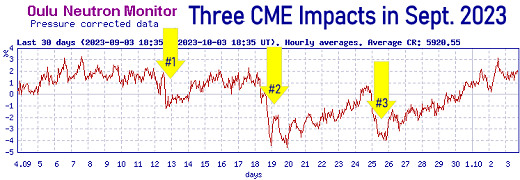
This is called a "Forbush decreases," named after American physicist Scott Forbush who studied cosmic rays in the early 20th century. It happens when a coronal mass ejection (CME) sweeps past Earth and pushes galactic cosmic rays away from our planet. Radiation from deep space hitting Earth’s upper atmosphere is briefly wiped out.
Normally, when cosmic rays hit the top of Earth's atmosphere, they produce a cascade of secondary particles that percolate down toward the ground. Using neutron counters, researchers in Oulu, Finland, have been monitoring these particles from space for almost 60 years. In the plot, above, we see how the three CMEs caused abrupt reductions in neutrons reaching the sensors in Finland.
The example of Sept. 2023 explains, in part, why the intensity of galactic cosmic rays drops around Solar Max. The sun keeps sweeping them away from our planet, ironically making space safer for astronauts and satellites.
Realtime Space Weather Photo Gallery
Free: Spaceweather.com Newsletter
THE NORTHERN HEMISPHERE OF THE SUN IS IN CHARGE: For the second month in a row, sunspot counts in the sun's northern hemisphere are more than double the south. The assymetry is obvious in this summary of September's sunspots compiled by astronomer Senol Sanli using data from NASA's Solar Dynamics Observatory:
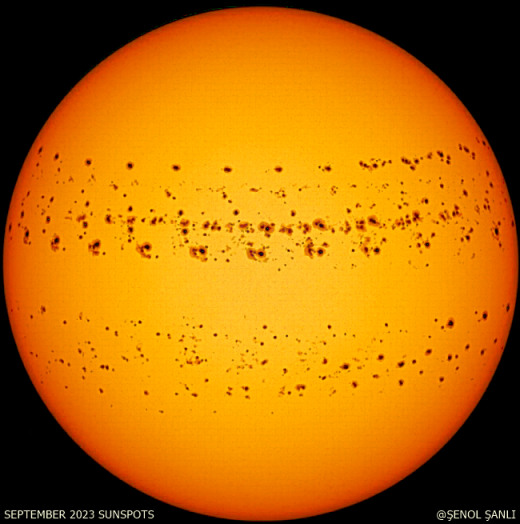
According to the Royal Observatory of Belgium's Solar Influences Data Analysis Center, in September the monthly sunspot number for the sun's northern hemisphere was 90, the southern hemisphere was only 44; that's a ratio of 2-to-1 in favor of the north. August was about the same. Looking back over an entire year, the north is leading the south by an average of 50%.
What's going on? In fact, it's not unusual for the sun's northern and southern hemispheres to be out of synch. As long ago as the 19th century, solar cycle pioneers Spoerer (1889) and Maunder (1890) noted that there were often long periods of time when most sunspots were found preferentially in one hemisphere and not the other. This plot from the Royal Observatory of Belgium shows assymetries throughout the last 6 solar cycles:
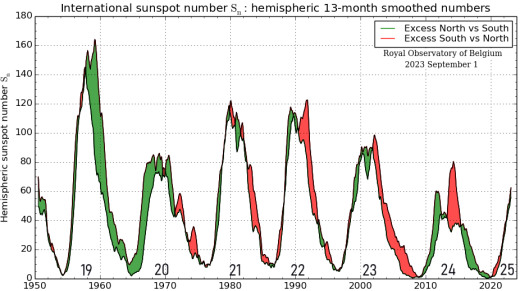
Until recently, Solar Cycle 25 was pretty evenly matched, north vs. south. Sunspot counts from August and September, however, suggest that the northern hemisphere may be seizing control--at least temporarily. This has happened during the upslope of all four previous solar cycles (21-24).
One possible explanation for this phenomenon may be that the two hemispheres of the sun have their own solar cycles, one out of phase with the other by about a year. Indeed, Solar Max is often double peaked. You can see it in the hemispheric sunspot plot. In the three most recent cycles (22-24), north peaked before south, creating two surges of solar activity separated by a "Gnevyshev gap." Solar Cycle 25 might continue this trend.
A complete discussion of sunspot asymmetries is included in David Hathaway's excellent review article "The Solar Cycle."
Realtime Space Weather Photo Gallery
Free: Spaceweather.com Newsletter
IRIDESCENT BLACK PEARL PENDANT: It came from Tahiti--and now it's been to the edge of space. On Aug. 29, 2023, this genuine Black Tahitian South Sea Cultured Pearl flew to the stratosphere onboard an Earth to Sky Calculus cosmic ray balloon, soaring 119,010 feet above the Sierra Nevada mountains of central California:
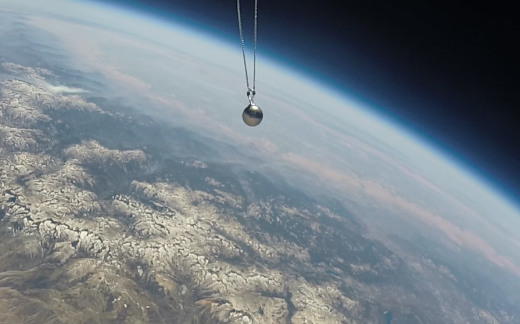
You can have it for $199.95. The 9 mm pearl has a lovely iridescent sheen that hints at a South Sea rainbow when held in sunlight. Its surface is so smooth, it reflected a tiny image of the Sierra from an altitude of 119,101 feet!
The students of Earth to Sky are selling space pendants to support their cosmic ray ballooning program. Each one comes with a greeting card showing the pendant in flight and telling the story of its trip to the stratosphere and back again.
Far Out Gifts: Earth to Sky Store
All sales support hands-on STEM education
Realtime Comet Photo Gallery
Free: Spaceweather.com Newsletter
Realtime Aurora Photo Gallery
Free: Spaceweather.com Newsletter
Every night, a network of
NASA all-sky cameras scans the skies above the United States for meteoritic fireballs. Automated software maintained by NASA's Meteoroid Environment Office calculates their orbits, velocity, penetration depth in Earth's atmosphere and many other characteristics. Daily results are presented here on Spaceweather.com.
On Oct 02, 2023, the network reported 5 fireballs.
(5 sporadics)
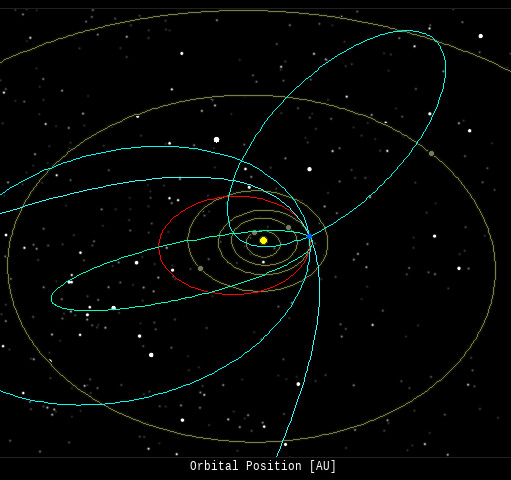
In this diagram of the inner solar system, all of the fireball orbits intersect at a single point--Earth. The orbits are color-coded by velocity, from slow (red) to fast (blue). [Larger image] [movies]
Potentially Hazardous Asteroids (
PHAs) are space rocks larger than approximately 100m that can come closer to Earth than 0.05 AU. None of the known PHAs is on a collision course with our planet, although astronomers are finding
new ones all the time.
On October 3, 2023 there were 2349 potentially hazardous asteroids.
 |
Recent & Upcoming Earth-asteroid encounters: | Asteroid | Date(UT) | Miss Distance | Velocity (km/s) | Diameter (m) |
| 2023 SY1 | 2023-Sep-28 | 7.2 LD | 10.1 | 12 |
| 2023 RF3 | 2023-Sep-28 | 15.4 LD | 7.7 | 38 |
| 2023 SW6 | 2023-Sep-28 | 3.5 LD | 11.9 | 18 |
| 2013 TG6 | 2023-Sep-28 | 3.6 LD | 4.1 | 17 |
| 2023 SE4 | 2023-Sep-29 | 5.3 LD | 4.6 | 14 |
| 2023 RF9 | 2023-Sep-29 | 10.6 LD | 9.2 | 26 |
| 2023 TA | 2023-Sep-30 | 1.1 LD | 3.3 | 9 |
| 2023 SC4 | 2023-Sep-30 | 12.4 LD | 8.3 | 22 |
| 2023 SL8 | 2023-Sep-30 | 2 LD | 12.6 | 46 |
| 2023 SA6 | 2023-Sep-30 | 16.4 LD | 9.7 | 22 |
| 2009 UG | 2023-Sep-30 | 6.1 LD | 9 | 78 |
| 2023 SY2 | 2023-Oct-01 | 9.1 LD | 9.9 | 21 |
| 2023 TB | 2023-Oct-02 | 2.6 LD | 13.3 | 16 |
| 349507 | 2023-Oct-03 | 16.5 LD | 21 | 696 |
| 2022 FX1 | 2023-Oct-04 | 20 LD | 9.9 | 25 |
| 2023 SN6 | 2023-Oct-04 | 12.6 LD | 8.5 | 27 |
| 2019 QO5 | 2023-Oct-05 | 19.9 LD | 9.4 | 61 |
| 2023 RF10 | 2023-Oct-05 | 15.8 LD | 5.8 | 27 |
| 2023 QC8 | 2023-Oct-05 | 15.8 LD | 6.3 | 41 |
| 2022 TD | 2023-Oct-07 | 8.9 LD | 9.4 | 10 |
| 2023 RR29 | 2023-Oct-07 | 9.2 LD | 8.1 | 37 |
| 2023 SA1 | 2023-Oct-08 | 17.9 LD | 5.9 | 26 |
| 2018 ER1 | 2023-Oct-08 | 12.5 LD | 5.3 | 27 |
| 2022 UX1 | 2023-Oct-11 | 3.1 LD | 8.6 | 9 |
| 2023 RD11 | 2023-Oct-11 | 12.8 LD | 9.6 | 39 |
| 2015 KW120 | 2023-Oct-12 | 18.2 LD | 13 | 22 |
| 2021 NT14 | 2023-Oct-13 | 18.6 LD | 8.6 | 254 |
| 2011 GA | 2023-Oct-15 | 6.8 LD | 16.6 | 230 |
| 2007 SQ6 | 2023-Oct-15 | 19.4 LD | 6.5 | 130 |
| 2019 UZ3 | 2023-Oct-16 | 9.6 LD | 8.3 | 14 |
| 1998 HH49 | 2023-Oct-17 | 3.1 LD | 14.8 | 193 |
| 2022 UO10 | 2023-Oct-19 | 7.8 LD | 9.8 | 16 |
| 2020 UR | 2023-Oct-20 | 5.8 LD | 12.9 | 9 |
| 2020 FM6 | 2023-Oct-23 | 15.5 LD | 15.9 | 149 |
| 2019 HH4 | 2023-Oct-24 | 13.3 LD | 20 | 365 |
| 2023 RA4 | 2023-Oct-24 | 8.4 LD | 3.9 | 48 |
| 2021 SZ4 | 2023-Oct-26 | 14 LD | 30 | 287 |
| 302169 | 2023-Oct-26 | 12.7 LD | 25.7 | 374 |
| 525229 | 2023-Oct-30 | 10.6 LD | 17.4 | 200 |
| 2013 UV3 | 2023-Nov-01 | 14.7 LD | 15.4 | 16 |
| 2016 WY | 2023-Nov-02 | 9.1 LD | 3.9 | 5 |
| 363505 | 2023-Nov-02 | 13.7 LD | 8 | 709 |
| 2022 JF | 2023-Nov-03 | 15.2 LD | 17.2 | 39 |
| 2023 QP8 | 2023-Nov-03 | 17.1 LD | 8.8 | 174 |
| 2016 VW2 | 2023-Nov-03 | 10.1 LD | 8.1 | 20 |
| 2019 UH7 | 2023-Nov-04 | 9.9 LD | 5.9 | 11 |
| 2014 BA3 | 2023-Nov-13 | 15.7 LD | 2.7 | 8 |
| 2021 TN3 | 2023-Nov-15 | 17 LD | 6.3 | 31 |
| 2019 VL5 | 2023-Nov-16 | 8.5 LD | 8.2 | 24 |
| 2019 LB1 | 2023-Nov-18 | 15.8 LD | 4.2 | 14 |
| 2016 DK1 | 2023-Nov-19 | 5.3 LD | 6.8 | 11 |
| 2022 VR1 | 2023-Nov-19 | 8.1 LD | 6.1 | 39 |
| 2019 UT6 | 2023-Nov-24 | 9 LD | 13.2 | 141 |
| 2019 CZ2 | 2023-Nov-25 | 2.8 LD | 5.8 | 43 |
| 2013 UB3 | 2023-Nov-27 | 18.5 LD | 5.4 | 25 |
Notes: LD means "Lunar Distance." 1 LD = 384,401 km, the distance between Earth and the Moon. 1 LD also equals 0.00256 AU. | | Cosmic Rays in the Atmosphere |
SPACE WEATHER BALLOON DATA: Almost once a week, Spaceweather.com and the students of Earth to Sky Calculus fly space weather balloons to the stratosphere over California. These balloons are equipped with sensors that detect secondary cosmic rays, a form of radiation from space that can penetrate all the way down to Earth's surface. Our monitoring program has been underway without interruption for 7 years, resulting in a unique dataset of in situ atmospheric measurements.
Latest results (July 2022): Atmospheric radiation is decreasing in 2022. Our latest measurements in July 2022 registered a 6-year low:
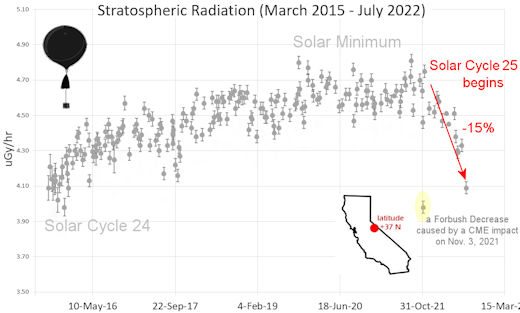
What's going on? Ironically, the radiation drop is caused by increasing solar activity. Solar Cycle 25 has roared to life faster than forecasters expected. The sun's strengthening and increasingly tangled magnetic field repels cosmic rays from deep space. In addition, solar coronal mass ejections (CMEs) sweep aside cosmic rays, causing sharp reductions called "Forbush Decreases." The two effects blend together to bring daily radiation levels down.
.Who cares? Cosmic rays are a surprisingly "down to Earth" form of space weather. They can alter the chemistry of the atmosphere, trigger lightning, and penetrate commercial airplanes. According to a study from the Harvard T.H. Chan school of public health, crews of aircraft have higher rates of cancer than the general population. The researchers listed cosmic rays, irregular sleep habits, and chemical contaminants as leading risk factors. A number of controversial studies (#1, #2, #3, #4) go even further, linking cosmic rays with cardiac arrhythmias and sudden cardiac death.
Technical notes: The radiation sensors onboard our helium balloons detect X-rays and gamma-rays in the energy range 10 keV to 20 MeV. These energies span the range of medical X-ray machines and airport security scanners.
Data points in the graph labeled "Stratospheric Radiation" correspond to the peak of the Regener-Pfotzer maximum, which lies about 67,000 feet above central California. When cosmic rays crash into Earth's atmosphere, they produce a spray of secondary particles that is most intense at the entrance to the stratosphere. Physicists Eric Regener and Georg Pfotzer discovered the maximum using balloons in the 1930s and it is what we are measuring today.
| | The official U.S. government space weather bureau |
| | The first place to look for information about sundogs, pillars, rainbows and related phenomena. |
| | Researchers call it a "Hubble for the sun." SDO is the most advanced solar observatory ever. |
| | 3D views of the sun from NASA's Solar and Terrestrial Relations Observatory |
| | Realtime and archival images of the Sun from SOHO. |
| | information about sunspots based on the latest NOAA/USAF Active Region Summary |
| | current counts of failed and deployed Starlink satellites from Jonathan's Space Page |
| | Authoritative predictions of space junk and satellite re-entries |
| | from the NOAA Space Environment Center |
| | fun to read, but should be taken with a grain of salt! Forecasts looking ahead more than a few days are often wrong. |
| | from the NOAA Space Environment Center |
| | the underlying science of space weather |
 | When looking for casinos to play online when the weather is bad, you can try casino online trucchi for Italian games. If you are not from Finland you can try the Swedish page Svenska casino online to find suitable games, check out svenskacasinoonline.net. Always check your local laws before playing with real money. |
 | BestCSGOGambling is the best site for everything related to CSGO gambling on the web |
| | These links help Spaceweather.com stay online. Thank you to our supporters! |
| | | | | | |

